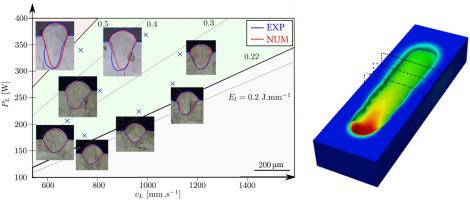当前位置:
X-MOL 学术
›
J. Mater. Process. Tech.
›
论文详情
Our official English website, www.x-mol.net, welcomes your
feedback! (Note: you will need to create a separate account there.)
Effect of processing parameters during the laser beam melting of Inconel 738: Comparison between simulated and experimental melt pool shape
Journal of Materials Processing Technology ( IF 6.7 ) Pub Date : 2021-03-01 , DOI: 10.1016/j.jmatprotec.2020.116897 D. Grange , A. Queva , G. Guillemot , M. Bellet , J.-D. Bartout , C. Colin
Journal of Materials Processing Technology ( IF 6.7 ) Pub Date : 2021-03-01 , DOI: 10.1016/j.jmatprotec.2020.116897 D. Grange , A. Queva , G. Guillemot , M. Bellet , J.-D. Bartout , C. Colin

|
Abstract Numerical simulation is a powerful tool to understand the link between processing parameters and solidification conditions during the laser beam melting (LBM) process. To be able to use this tool for microstructural control, numerical models need to be validated on a large set of experimental conditions, to ensure that the model describes the predominant physical phenomena. In this study, an experimental set of twenty tracks was produced in an Inconel 738 alloy, with a wide range of energy input and scanning speed. Experimental melt pool shapes were compared to the predictions of a multiphysics numerical model. In this model, the powder bed is considered as a continuum. The laser source is modeled with a Beer-Lambert absorption law, and surface tension, Marangoni force and recoil pressure are the driving forces for melt pool dynamics. This kind of model offers an efficient computational time, but requires a calibration of the absorption coefficient and a representative description of laser-matter interaction. In order to represent correctly heat and mass transfer during laser-matter interaction, the model needs to account for the loss of matter caused by the ejection of powder particles and spatters. A novel calibration method was proposed to calculate the absorption coefficient. This method uses the experimental cross sections of the melt pools and a simplified analytical expression of energy balance. The use of this calibration method enabled a good agreement between experiments and calculations on a large process window. The values obtained by the calibrations resulted in a phenomenological expression of absorptivity coefficient with process parameters. Based on this expression, a comparison was made with another numerical model from literature using a time-consuming ray-tracing method in order to calculate the absorptivity coefficient. Similar results have been obtained, demonstrating the potential of the proposed approach to predict the melt pool shape and thus better understand the combined effect of laser-matter interaction and solidification in LBM process.
中文翻译:

Inconel 738 激光束熔化过程中加工参数的影响:模拟熔池形状与实验熔池形状的比较
摘要 数值模拟是了解激光束熔化 (LBM) 过程中加工参数与凝固条件之间联系的有力工具。为了能够使用该工具进行微观结构控制,需要在大量实验条件下验证数值模型,以确保模型描述了主要的物理现象。在这项研究中,使用 Inconel 738 合金制作了一组 20 条轨道,具有广泛的能量输入和扫描速度。将实验熔池形状与多物理场数值模型的预测进行了比较。在这个模型中,粉末床被认为是一个连续体。激光源采用 Beer-Lambert 吸收定律建模,表面张力、Marangoni 力和反冲压力是熔池动力学的驱动力。这种模型提供了有效的计算时间,但需要校准吸收系数和激光-物质相互作用的代表性描述。为了正确表示激光与物质相互作用期间的热量和质量传递,该模型需要考虑由粉末颗粒和飞溅物的喷射引起的物质损失。提出了一种新的校准方法来计算吸收系数。该方法使用熔池的实验横截面和能量平衡的简化分析表达式。使用这种校准方法可以在大工艺窗口上实现实验和计算之间的良好一致性。通过校准获得的值导致吸收系数与工艺参数的现象学表达。基于此表达式,使用耗时的光线追踪方法与文献中的另一个数值模型进行比较,以计算吸收系数。已经获得了类似的结果,证明了所提出的方法在预测熔池形状方面的潜力,从而更好地了解 LBM 过程中激光-物质相互作用和凝固的组合效应。
更新日期:2021-03-01
中文翻译:

Inconel 738 激光束熔化过程中加工参数的影响:模拟熔池形状与实验熔池形状的比较
摘要 数值模拟是了解激光束熔化 (LBM) 过程中加工参数与凝固条件之间联系的有力工具。为了能够使用该工具进行微观结构控制,需要在大量实验条件下验证数值模型,以确保模型描述了主要的物理现象。在这项研究中,使用 Inconel 738 合金制作了一组 20 条轨道,具有广泛的能量输入和扫描速度。将实验熔池形状与多物理场数值模型的预测进行了比较。在这个模型中,粉末床被认为是一个连续体。激光源采用 Beer-Lambert 吸收定律建模,表面张力、Marangoni 力和反冲压力是熔池动力学的驱动力。这种模型提供了有效的计算时间,但需要校准吸收系数和激光-物质相互作用的代表性描述。为了正确表示激光与物质相互作用期间的热量和质量传递,该模型需要考虑由粉末颗粒和飞溅物的喷射引起的物质损失。提出了一种新的校准方法来计算吸收系数。该方法使用熔池的实验横截面和能量平衡的简化分析表达式。使用这种校准方法可以在大工艺窗口上实现实验和计算之间的良好一致性。通过校准获得的值导致吸收系数与工艺参数的现象学表达。基于此表达式,使用耗时的光线追踪方法与文献中的另一个数值模型进行比较,以计算吸收系数。已经获得了类似的结果,证明了所提出的方法在预测熔池形状方面的潜力,从而更好地了解 LBM 过程中激光-物质相互作用和凝固的组合效应。











































 京公网安备 11010802027423号
京公网安备 11010802027423号